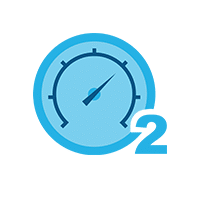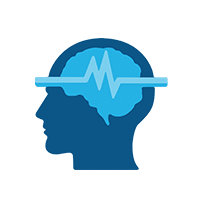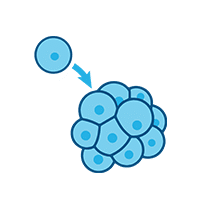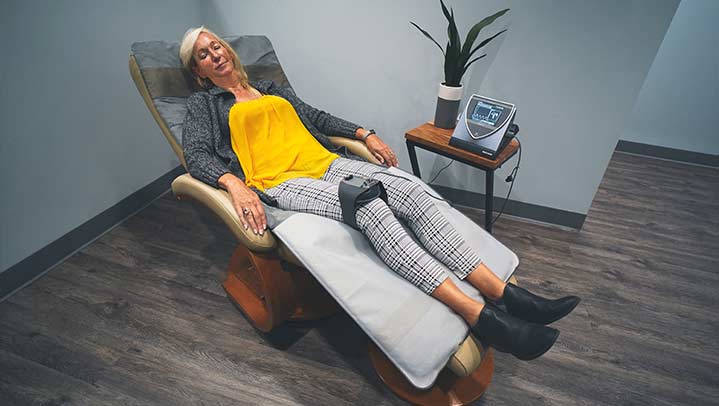Migraine Headaches
Migraine headaches affect roughly 21% of women and 9% of men in the U.S. and are extremely debilitating for the affected individual(1). A migraine headache refers to an intense, painful pulsing or throbbing that typically occurs on one side of the head. Migraines are different from a normal headache in that they are often accompanied by nausea, light and/or sound sensitivity, and vomiting that significantly impairs daily living(2). Unfortunately, the primary treatment for migraines are medications that only relieve pain in the short-term and may cause side effects and overuse issues(3). While preventative migraine medications do exist, less than half of those with migraines use them due to the countless side-effects and poor efficacy(4, 5). We offer multiple therapies that have proven benefits for both acute and long-term migraine management.
Extivita Therapies for Migraine Headaches:
Extivita Therapies Migraine Headaches:

Hyperbaric Oxygen Therapy

Neurofeedback

Supplements

Nutritional IV Therapy

Pulsed Electromagnetic Field Therapy
Hyperbaric Oxygen Therapy for Migraine Headaches:
Hyperbaric oxygen therapy (HBOT) can relieve acute migraines by directly combating decreased oxygen levels (hypoxia)(6). Hypoxia is believed to trigger migraines by inducing something called cortical spreading depression (CSD), which results in suppressed brain activity and altered neural and vascular function(7). HBOT significantly increases oxygen concentration in the blood and tissues, thus resolving the issue of hypoxia and relieving migraine pain(8).
Inflammation in the brain is also believed to play some role in migraines, and HBOT has proven effects on reducing neuroinflammation(9, 10). The potential of these HBOT mechanisms to relieve acute migraines has been realized in multiple studies. Specifically, research suggests that HBOT can significantly relieve migraine symptoms when administered directly before or during a migraine attack(11, 12).
Benefits of HBOT for Migraine Headaches:
- Increases oxygen levels in the brain
- Increases blood flow in the brain
- Decreases neuroinflammation
Effects of HBOT on Migraine Headaches:

New Blood Vessel Formation

Increased Stem Cell Activity

Decreased Inflammation
Neurofeedback for Migraine Headaches:
Neurofeedback can be extremely effective in reducing the frequency, severity and duration of migraines. Common protocols for relieving migraines involve reducing theta (4-7 Hz) and high beta (20-30Hz), increasing low beta (12-15Hz), and sometimes increasing alpha (8-12Hz). The training location varies per patient, but the best results are typically seen when training over the frontal or central regions along the midline(13, 14, 15). These protocols can be highly effective because they help stabilize the brain hypersensitivity common in people with migraines(14, 16). While the number of required sessions varies per person, many people begin to notice a reduction in migraine frequency and severity within 5-8 sessions.
Common EEG Abnormalities in Migraine Headaches:
- Increased global relative theta activity (4-7Hz)(17-18, 20)
- Increased high beta activity (20-30Hz)(15, 21)
- Decreased alpha activity (8-12Hz)(18, 19)
IV Therapy for Migraine Headaches:
The migraine IV contains magnesium and vitamin B6, both of which have proven benefits for relieving migraines. Magnesium has repeatedly been shown to reduce the frequency of migraines (how often they occur), as well as the severity of migraines(22, 23). Vitamin B6 reduces the severity and duration of migraines(24). Many patients report that the pain associated with their migraine is rapidly relieved following specialized migraine IV’s.
Benefits of IV Therapy for Migraine Headaches:
- Quickly Reduces Severity of Migraines
- Reduces Frequency of Migraines
- Reduces Duration of Migraines

Pulsed Electromagnetic Field Therapy for Migraine Headaches:
Pulsed electromagnetic field therapy (PEMF) has proven to be effective in reducing migraine headaches. In multiple studies, migraineurs who received 10-20 PEMF sessions experienced a significant reduction in days with a migraine, duration of migraines, and severity of migraines(25-27). These improvements persisted for up to 8 months following the PEMF sessions, suggesting that PEMF may provide long-term relief of migraines(25, 26). Such benefits are likely due to PEMF’s ability to reduce hypoperfusion, which is a common issue in those with migraines(28). Other potential mechanisms include PEMF’s anti-inflammatory effects, it’s ability to increase serotonin and dopamine synthesis, and it’s benefits for mitochondria(29-31).
Benefits of PEMF for Migraine Headaches:
News & Research for Migraine Headaches:
Magnesium in Migraine Prophylaxis-Is There an Evidence-Based Rationale? A Systematic Review
Abstract Objective: The primary objective was to systematically evaluate the existing evidence base on magnesium in migraine prophylaxis. Methods: The search for clinical trials published from 1990 to 2016 was separately conducted by AvL and FR using standard search...
Meta-Synthesis on Migraine Management
Abstract Background: Migraine is one of the top 10 most disabling conditions among adults worldwide. Most migraine research is quantitative and indicates concerns about medication adherence, stigma, and more. Qualitative studies might reveal an improved understanding...
The potential impact of primary headache disorders on stroke risk.
Abstract: Headache such as migraine is associated with stroke. Studies focused on primary headache disorders (PHDs) as a risk factor for stroke are limited. The purpose of this population-based cohort study was to explore whether patients with PHDs were at a high risk...
References
- Burch, Rebecca, et al. “The Prevalence and Impact of Migraine and Severe Headache in the United States: Figures and Trends From Government Health Studies.” Headache, vol. 58, no. 4, Apr. 2018, pp. 496–505. PubMed, doi:10.1111/head.13281.
- Migraine Information Page | National Institute of Neurological Disorders and Stroke. https://www.ninds.nih.gov/Disorders/All-Disorders/Migraine-Information-Page. Accessed 6 Nov. 2020.
- Ong, Jonathan Jia Yuan, and Milena De Felice. “Migraine Treatment: Current Acute Medications and Their Potential Mechanisms of Action.” Neurotherapeutics, vol. 15, no. 2, Apr. 2018, pp. 274–90. Springer Link, doi:10.1007/s13311-017-0592-1.
- Lipton, R. B., et al. “Migraine Prevalence, Disease Burden, and the Need for Preventive Therapy.” Neurology, vol. 68, no. 5, Jan. 2007, p. 343, doi:10.1212/01.wnl.0000252808.97649.21.
- Minen, Mia T., et al. “Meta-Synthesis on Migraine Management.” Headache: The Journal of Head and Face Pain, vol. 58, no. 1, 2018, pp. 22–44. Wiley Online Library, doi:10.1111/head.13212.
- Arngrim, Nanna, et al. “Migraine Induced by Hypoxia: An MRI Spectroscopy and Angiography Study.” Brain, vol. 139, no. 3, Oxford Academic, Mar. 2016, pp. 723–37. academic.oup.com, doi:10.1093/brain/awv359.
- Charles, Andrew C., and Serapio M. Baca. “Cortical Spreading Depression and Migraine.” Nature Reviews Neurology, vol. 9, no. 11, 11, Nature Publishing Group, Nov. 2013, pp. 637–44. www.nature.com, doi:10.1038/nrneurol.2013.192.
- Choudhury, Ryan. “Hypoxia and Hyperbaric Oxygen Therapy: A Review.” International Journal of General Medicine, vol. 11, Nov. 2018, pp. 431–42. PubMed Central, doi:10.2147/IJGM.S172460.
- Malhotra, Rakesh. “Understanding Migraine: Potential Role of Neurogenic Inflammation.” Annals of Indian Academy of Neurology, vol. 19, no. 2, 2016, pp. 175–82. PubMed Central, doi:10.4103/0972-2327.182302.
- Thom, Stephen R. “Hyperbaric oxygen – its mechanisms and efficacy.” Plastic and Reconstructive Surgery, vol. 127, no. Suppl 1, Jan. 2011, pp. 131S-141S. PubMed Central, doi:10.1097/PRS.0b013e3181fbe2bf.
- Myers, Daniel E., and Roy A. Myers. “A Preliminary Report on Hyperbaric Oxygen in the Relief of Migraine Headache.” Headache: The Journal of Head and Face Pain, vol. 35, no. 4, 1995, pp. 197–99. Wiley Online Library, doi:10.1111/j.1526-4610.1995.hed3504197.x.
- Wilson, J. R., et al. “Hyperbaric oxygen in the treatment of migraine with aura.” Headache, vol. 38, no. 2, Feb. 1998, pp. 112–15. PubMed, doi:10.1046/j.1526-4610.1998.3802112.x.
- Sand, T. “Electroencephalography in Migraine: A Review with Focus on Quantitative Electroencephalography and the Migraine vs. Epilepsy Relationship.” Cephalalgia, vol. 23, no. s1, 2003, pp. 5–11. Wiley Online Library, doi:10.1046/j.1468-2982.2003.00570.x.
- Siniatchkin, M., et al. “Self-Regulation of Slow Cortical Potentials in Children with Migraine: An Exploratory Study.” Applied Psychophysiology and Biofeedback, vol. 25, no. 1, Mar. 2000, pp. 13–32. PubMed, doi:10.1023/a:1009581321624.
- Walker, Jonathan E. “QEEG-Guided Neurofeedback for Recurrent Migraine Headaches.” Clinical EEG and Neuroscience, vol. 42, no. 1, SAGE Publications Inc, Jan. 2011, pp. 59–61. SAGE Journals, doi:10.1177/155005941104200112.
- Gerber, W. D., and J. Schoenen. “Biobehavioral Correlates in Migraine: The Role of Hypersensitivity and Information-Processing Dysfunction.” Cephalalgia: An International Journal of Headache, vol. 18 Suppl 21, Feb. 1998, pp. 5–11. PubMed, doi:10.1177/0333102498018s2103.
- Facchetti, Dante, et al. “Cerebral Mapping in Subjects Suffering from Migraine with Aura.” Cephalalgia, vol. 10, no. 6, 1990, pp. 279–84. Wiley Online Library, doi:10.1046/j.1468-2982.1990.1006279.x.
- Lia., C., Carenini, L., Degioz, C. et al. Computerized EEG analysis in migraine patients. Ital J Neuro Sci 16, 249–254 (1995). https://doi.org/10.1007/BF02282996
- Neufeld, M. Y., et al. “EEG and Topographic Frequency Analysis in Common and Classic Migraine.” Headache: The Journal of Head and Face Pain, vol. 31, no. 4, 1991, pp. 232–36. Wiley Online Library, doi:10.1111/j.1526-4610.1991.hed3104232.x.
- Bjørk, Marte Helene, et al. “Interictal Quantitative EEG in Migraine: A Blinded Controlled Study.” The Journal of Headache and Pain, vol. 10, no. 5, 5, BioMed Central, Oct. 2009, pp. 331–39. thejournalofheadacheandpain.biomedcentral.com, doi:10.1007/s10194-009-0140-4.
- Clemens, Béla et al. “Three-dimensional localization of abnormal EEG activity in migraine: a low resolution electromagnetic tomography (LORETA) study of migraine patients in the pain-free interval.” Brain topography vol. 21,1 (2008): 36-42. doi:10.1007/s10548-008-0061-6
- Wang, Fong, et al. “Oral Magnesium Oxide Prophylaxis of Frequent Migrainous Headache in Children: A Randomized, Double-Blind, Placebo-Controlled Trial.” Headache, vol. 43, no. 6, June 2003, pp. 601–10. PubMed, doi:10.1046/j.1526-4610.2003.03102.x.
- von Luckner, Alexander, and Franz Riederer. “Magnesium in Migraine Prophylaxis—Is There an Evidence‐Based Rationale? A Systematic Review.” Headache: The Journal of Head and Face Pain, vol. 58, no. 2, Wiley Subscription Services, Inc, 2018, pp. 199–209. wfu.primo.exlibrisgroup.com, doi:10.1111/head.13217.
- Sadeghi, Omid, et al. “Effects of Pyridoxine Supplementation on Severity, Frequency and Duration of Migraine Attacks in Migraine Patients with Aura: A Double-Blind Randomized Clinical Trial Study in Iran.” Iranian Journal of Neurology, vol. 14, no. 2, Apr. 2015, pp. 74–80.
- Sherman, Richard A., et al. “Treatment of Migraine With Pulsing Electromagnetic Fields: A Double-Blind, Placebo-Controlled Study.” Headache: The Journal of Head and Face Pain, vol. 39, no. 8, 1999, pp. 567–75. Wiley Online Library, doi:https://doi.org/10.1046/j.1526-4610.1999.3908567.x.
- Pelka, R. B., et al. “Impulse Magnetic-Field Therapy for Migraine and Other Headaches: A Double-Blind, Placebo-Controlled Study.” Advances in Therapy, vol. 18, no. 3, June 2001, pp. 101–09. PubMed, doi:10.1007/BF02850298.
- Hatef, Boshra, et al. “The Efficiency of Pulsed Electromagnetic Field in Refractory Migraine Headaches: A Randomized, Single-Blinded, Placebo-Controlled, Parallel Group.” Site Map | Help Search INTERNATIONAL JOURNAL OF CLINICAL TRIALS, vol. 3, Feb. 2016, pp. 24–31. ResearchGate, doi:10.18203/2349-3259.ijct20160475.
- M, Denuelle, et al. “Posterior Cerebral Hypoperfusion in Migraine without Aura.” Cephalalgia : An International Journal of Headache, vol. 28, no. 8, May 2008, pp. 856–62. europepmc.org, doi:10.1111/j.1468-2982.2008.01623.x.
- Habash, Riadh. Bioeffects and Therapeutic Applications of Electromagnetic Energy. 1st ed., CRC Press, 2019, https://www.routledge.com/Bioeffects-and-Therapeutic-Applications-of-Electromagnetic-Energy/Habash/p/book/9780367388249.
- Sieroń, Aleksander, et al. “Alternating Extremely Low Frequency Magnetic Field Increases Turnover of Dopamine and Serotonin in Rat Frontal Cortex.” Bioelectromagnetics, vol. 25, no. 6, Sept. 2004, pp. 426–30. PubMed, doi:10.1002/bem.20011.
- Tong, James Jiayuan. “Mitochondrial Delivery Is Essential for Synaptic Potentiation.” The Biological Bulletin, vol. 212, no. 2, Apr. 2007, pp. 169–75. PubMed, doi:10.2307/25066594.



